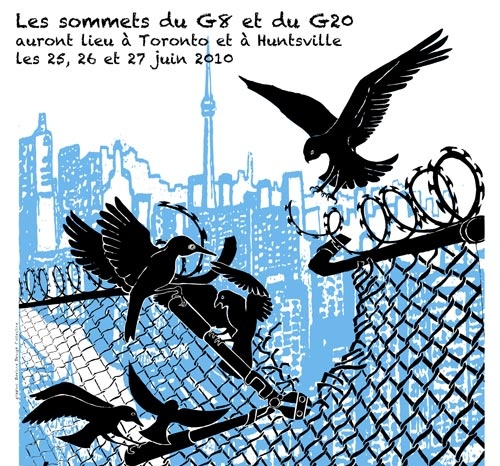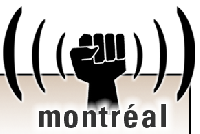 |
 |
 |
 |
 |
 |
|
 |
 |
 |
 |
 |
 |
 |
Régions du Québec |  |
 |
 |
|
 |
 |
|
 |
 |
|
 |
 |
 |
 |
 |
 |
Rubriques (sujets) |  |
 |
 |
|
 |
 |
|
 |
|
 |
 |
 |
THE INSURRECTIONAL PROJECT
An anarchist insurrectional project requires a method that reflects the world we desire and the reality of the world we seek to destroy. Acting in small groups based on affinity fits both of these requirements. Power in the present world no longer has a real center, but spreads itself throughout the social terrain. Acting in small groups allows projects of attack to spread across the terrain as well. But more significantly, this method brings one’s aim into one’s method—revolt itself becomes a different way of conceiving relations. Anarchists always talk of refusing vanguardism—but such a refusal means refusing evangelism, the quantitative myth that seeks to win converts to an ideology of anarchism. Acting in small groups to attack the state and capital puts anarchy into practise as the self-organization of one’s own projects, in relations based on affinity—real knowledge of and trust in each other—rather than adherence to a belief system. Furthermore, this sort of action, liberated from the quantitative, does not wait until “conditions are right
SOME IDEAS ON INSURRECTIONAL ANARCHIST ORGANIZATION
Once one has decided not to put up with being ruled or exploited and therefore to attack the social order based on domination and exploitation, the question of how to go about this arises. Since those of us who rise up in rebellion cannot let themselves be organized by others without falling under a new form of domination, we need to develop the capacity to organize our own projects and activities—to put the elements together that are necessary for acting projectually in a coherent manner.
Thus, organization, as I’m using the term here, means bringing together the means and relations that allow us to act for ourselves in the world. This starts with the decision to act, the decision that our thirst to have all of our life as our own requires us to fight against the state, capital and all of the structures and institutions through which they maintain control over the conditions of our existence. Such a decision puts one in the position of needing to develop the specific tools that make intelligent action possible. First a thorough analysis of the present conditions of exploitation is necessary. Based on this analysis, we choose specific objectives to aim for and means for achieving these objectives based upon our desires and the ideas that move us. These means, these tools for action must first and foremost include ways of making our objectives, desires and ideas known to others in order to find affinities, others with whom we can create projects of action. Thus, we look to create occasions for encounters and discussion in which similarities and differences are clarified, in which the refusal of false unities allow the real affinities—real knowledge of whether and how we can work together—can develop. These tools allow the projectuality of individuals in revolt to become a force in movement, an element propelling toward the insurrectional break. Since affinity is the basis for the relations we are aiming to use in action, informality is essential—only here can its forms be expressions of real needs and desires.
So our desire to create insurrection moves us to reject all formal organization—all structures based on membership and the attempt to synthesize the various struggles under one formal leadership—that of the organization. These structures for synthesis share some common traits. They have a formal theoretical basis, a series of doctrine to which all members are expected to adhere. Because such groups are seeking numbers this basis tends to be on the lowest common denominator—a set of simplistic statements with no depth of analysis and with a dogmatic tendency that militates against deep analysis. They also have a formal practical orientation—a specific mode of acting by which the group as a whole determines what they will do. The necessity such groups feel to synthesize the various struggle under their direction—to the extent they succeed—leads to a formalization and ritualization of the struggles undermining creativity and imagination and turning the various struggles into mere tools for the promotion of the organization. From all of this it becomes clear, that whatever claims such an organization may make about its desire for insurrection and revolution, in fact its first aim is to increase membership. It is important to realize that this problem can exist even when no structures have been created. When anarchism promotes itself in an evangelistic manner, it is clear that a formal theoretical basis has imposed its rigidity on the fluidity of ideas necessary for developing real analyses. In such a situation, the practical orientation—the modes of action also become formalized—one need only look at the ritualized confrontations by which so many anarchists strive to get their message across. The only purpose that this apparently informal formalization serves is to try to convince the various people in struggle that they should call themselves anarchists—that is, to synthesize the struggles under the leadership of the black flag. In other words to gain numbers of members for this formal non-organization. Dealing with the media to explain who anarchists are seems to enforce this way of interacting with the other exploited in struggle, because it reinforces the separation of anarchists from the rest of those exploited by this society and leaves the impression that the anarchists have some special understanding of things that makes them the de facto vanguard of the revolution.
So for the purpose of creating our insurrectional project we want to organize informally: without a formal theoretical basis so that ideas and analyses can be developed fluidly in a way that allows to understand the present and act against it and without a formal practical orientation so that we can act with an intelligent projectual spontaneity and creativity. A significant aspect of this informal organization would be a network of like-minded people. This network would base itself on a reciprocal knowledge of each other which requires honest, straightforward discussions of ideas, analyses and aims. Complete agreement would not be necessary, but a real understanding of differences would. The aim of this network would not be the recruitment of members—it would not be a membership organization—but rather developing methods for intervening in various struggles in an insurrectional manner, and coordinating such intervention. The basis for participation would be affinity—meaning the capacity to act together. This capacity stems from knowing where to find each other and studying and analyzing the social situation together in order to move to action together. . Since there is no formal organization to join, this network would only grow an the basis of real affinity of ideas and practise. This informal network would consist of the tools we develop for the discussion of social analyses and the methods for intervening in struggles that we create.
This network is basically a way for individuals and small groups to coordinate their struggles. The real point of action is the affinity group. An affinity group is an informal, temporary group based on affinity—that is real knowledge of each other—that comes together to accomplish a specific aim. Affinity develops through a deepening knowledge of each other: knowledge of how the other thinks about social problems and of the methods of intervention they consider appropriate. Real affinity cannot be based on a lowest common denominator, but must include a real understanding of differences as well as similarities between those involved, because it is in the knowledge of our difference that we can discover haw we can really act together. Since the affinity group comes together for a specific circumscribed aim, it is a temporary formation—one that ceases to exist once the aim is accomplished. Thus it remains informal, without membership.
With this informal basis, once we recognize that our own freedom will remain impoverished as long as the masters continue to control the conditions under which most people exist, depriving them of the ability to freely determine their own lives, we recognize that our own liberation depends on intervention in the struggles of the exploited classes as a whole. Our involvement is not one of evangelism—the propagandistic method would place us on the same level as political movements, and we are not politicians or activists, but individuals who want our lives back and therefore take action for ourselves with others. Thus, we do not propose any specific anarchist organization for the exploited to join, nor a doctrine to put faith in. Rather we seek to link our specific struggle as anarchists to that of the rest of the exploited by encouraging self-organization, self-determination, the refusal of delegation and of any sort of negotiation, accommodation or compromise with power, and a practise based on direct action and the necessity of attack against the structures of power and control. The point is to encourage and participate in specific attacks against specific aspects of the state, capital and the various structures and apparati of control. Since our purpose is to struggle against our own exploitation with other exploited people, certainly with the aim of projecting toward insurrection, there can be no guaranteeing of any results—with no organization striving to gain members, we can’t look for an increase in numbers. There is no way to know the end. But though we have know guarantees, no certainty of accomplishing our aim, success is not the primary reason for our struggle. The primary reason is that not to act is the guaranteed defeat of an empty and meaningless existence. To act to take our life back is to already regain it on the terrain of struggle, to already become the creator of one’s own existence, even if in constant battle with a monstrous order determined to crush us.
WHY WE ARE INSURRECTIONALIST ANARCHISTS
-Because we are struggling along with the excluded to alleviate and ultimately abol
 |
 |
 |
 |
Dossier G20 |  |
 |
 |
|
 |
 |
|
 |
Nous vous offrons plusieurs reportages indépendants et témoignages...

Liste des activités lors de ce « contre-sommet » à Toronto Vous pouvez aussi visiter ces médias alternatifs anglophones... Centre des médias Alternatifs Toronto 2010.mediacoop.net Media Co-op Toronto http://toronto.mediacoop.ca Toronto Community Mobilization www.attacktheroots.net (en Anglais) |
 |
 |
 |
 |
 |
 |
 |
CMAQ: Vie associative |  |
 |
 |
|
 |
 |
|
 |
 Collectif à Québec: n'existe plus. Impliquez-vous ! |
 |
 |
 |
 |
 |
 |
 |
 |
|
 |
 |
 |
Ceci est un média alternatif de publication ouverte. Le collectif CMAQ, qui gère la validation des contributions sur le Indymedia-Québec, n'endosse aucunement les propos et ne juge pas de la véracité des informations. Ce sont les commentaires des Internautes, comme vous, qui servent à évaluer la qualité de l'information. Nous avons néanmoins une
Politique éditoriale
, qui essentiellement demande que les contributions portent sur une question d'émancipation et ne proviennent pas de médias commerciaux.
This is an alternative media using open publishing. The CMAQ collective, who validates the posts submitted on the Indymedia-Quebec, does not endorse in any way the opinions and statements and does not judge if the information is correct or true. The quality of the information is evaluated by the comments from Internet surfers, like yourself. We nonetheless have an
Editorial Policy
, which essentially requires that posts be related to questions of emancipation and does not come from a commercial media.


